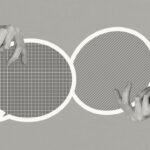Have you ever felt like your thoughts are trapped and your emotions are unspoken? In a world where rational thought is highly valued, spontaneous expression of what is hidden deep in the mind is often suppressed. Thousands of people struggle with mental health issues every day, not knowing that the key to healing may lie in releasing the unfiltered stream of consciousness.
Free association, a method so simple in concept yet so powerful in action, offers a path to the deeper layers of the psyche. It’s not about what you say, but how you allow your subconscious to speak. This technique, a foundation of psychoanalysis, allows you to access hidden thought patterns, repressed memories, and unresolved internal conflicts that can be the source of today’s emotional difficulties.
In this article, you will discover how the practice of free association can transform the therapeutic process. You will learn both the theoretical foundations of this method and practical tips for its use. Whether you are a person seeking self-understanding or a mental health professional, understanding the mechanisms of free association will open up new perspectives on your path to psychological healing and personal growth.
The origins and development of the free association method
The method of free association has its origins in the late 19th century, when psychoanalysis was just emerging as a field of science. Sigmund Freud, inspired by Josef Breuer's experiments with hypnosis, noticed that allowing patients to freely express their thoughts without censorship brought unexpected therapeutic results. It was the observations of Breuer's patient, Anna O., who called her therapy „talking cure” (talking healing), became the foundation for the development of this revolutionary psychoanalytic technique.
In the early stages of the development of the method, Freud still used the techniques of suggestion and laying hands on the patient's forehead to help him generate associations. However, he eventually abandoned these practices, recognizing that the most valuable therapeutic material appears when the patient is completely free to express himself. Free associations have become the royal road to the unconscious. – made it possible to reach repressed psychological contents which, according to psychoanalytic theory, were at the root of neurotic disorders.
Turn.
In the 1920s, the method of free association was recognized as the main technique in classical psychoanalysis. Subsequent generations of psychoanalysts, including Anna Freud, Melanie Klein, and Jacques Lacan, developed and modified this method, adapting it to their own theoretical concepts. Of particular importance was the discovery that the process of free association reveals not only repressed content, but also the patient's defense mechanisms, ways of coping with anxiety, and relationships with important objects. As psychoanalysis evolved, the method of free association ceased to be seen solely as a tool for discovering hidden memories, and began to be understood as a comprehensive process enabling the reconstruction of the patient's inner world, their unconscious conflicts, and the relational patterns that shape their functioning in everyday life.
Mechanism of action and theoretical assumptions
Free associations are a fundamental psychoanalytic technique, the mechanism of which is based on the disclosure of unconscious content. The patient is asked to freely express his thoughts without censorship or self-criticism, allowing the mind to naturally flow associationsThis seemingly simple process opens the door to deep layers of the psyche, inaccessible through conscious reflection.
The theoretical assumptions of this method are derived from Freud's belief that our unconscious thoughts and desires have a significant influence on our behavior, even though they remain hidden from consciousness. When the patient allows himself to express himself freely, the defense mechanisms gradually weaken, and the repressed content begins to break through to consciousness.
The effectiveness of free associations is due to several key factors:
Bypassing defense mechanisms: When the mind is not focused on a specific topic, it is more difficult for it to actively block out unwanted content. It's like watching a river of thoughts - instead of trying to control it, we let it flow naturally., which allows us to see what usually remains hidden.
The therapeutic process using free association goes through characteristic phases. At first, patients often experience resistance, reluctant to share thoughts that seem irrelevant or embarrassing. Over time, as trust in the therapist grows and comfort with the method increases, deeper psychological content emerges, revealing thought patterns, internal conflicts, and sources of anxiety.
Key aspects of the free association process are:
– discovering hidden connections between seemingly separate thoughts
– identifying recurring themes and symbols
– recognizing defense mechanisms activated during the session
– noticing transference reactions towards the therapist
Practical application in psychotherapy
Free associations are a fundamental technique in everyday psychotherapeutic practice, especially in the psychoanalytic approach. In the therapist's office, the patient is encouraged to freely express his or her thoughts, without censorship or judgment. The key to effective free association work is to create a safe space, in which the patient feels comfortable sharing even the most intimate or disturbing content.
How to begin working with free associations? The therapist usually asks the patient to lie comfortably on a couch (although this is not necessary at this time) and talk about anything that comes to mind. It could be a memory, a feeling, a fantasy, or a seemingly insignificant thought. All of these elements can lead to deeper, hidden content in the unconscious.
Using this method requires patience on the part of both the therapist and the patient. Many beginners experience difficulty in “turning off” the inner critic and allowing their thoughts to flow freely. This is natural! Over time, as trust in the therapist grows, the process becomes more fluid and effective. Remember, there are no “bad” or “stupid” associations – each can be a valuable clue.
In practice, free associations can lead to unexpected discoveries. For example, a patient talking about an everyday problem may suddenly connect it with a forgotten childhood memory that sheds new light on the current difficulties. Such moments of breakthrough often lead to profound insight and are crucial to the healing process..
What to do when resistance occurs? Resistance to certain topics—when a patient suddenly changes the subject, forgets the thread, or falls silent—is valuable information for the therapist. It indicates areas of internal conflict that require gentle exploration. Use this phenomenon as a guide to where to go in therapy, not as an obstacle to overcome.
Effectiveness and limitations of the method
Let's imagine a typical day for Anna, who has been participating in free association therapy for three months. She starts the morning by writing down her dreams and first thoughts in a journal, which has become a key ritual since starting therapy. During the afternoon therapy session, lying comfortably on the couch, Anna lets her thoughts flow freely, speaking them without censorship. Unlike the early sessions, when every word was carefully chosen and filtered, now her statements become increasingly authentic and spontaneous. It is in these moments of unstructured expression that unexpected connections between childhood memories and her current social anxieties emerge.
The method of free associations, although extremely effective in reaching the hidden contents of the unconscious, it also encounters clear limitations. On the one hand, it allows patients to discover deeply rooted thought and emotional patterns, but on the other hand, it requires significant time and emotional involvement. The effectiveness of this technique depends largely on the patient's willingness to cooperate and their ability to trust the therapist. In the case of people with strong defense mechanisms or traumatic experiences, free associations may initially lead to increased anxiety instead of bringing relief. Therefore, an experienced therapist must skillfully balance between encouraging free expression and ensuring a sense of security, adjusting the pace and intensity of work to the individual needs of each patient.
Contemporary modifications and integration with other approaches
The technique of free association, although derived from classical psychoanalysis, has undergone significant evolution over the last century. Modern therapists have adapted the method to changing psychological paradigms, preserving its essence while enriching it with new elements. This transformability of the technique testifies to its extraordinary flexibility and lasting therapeutic value.
Integrating free association with cognitive behavioral therapy (CBT) is one of the most promising areas of development. Therapists combine the free flow of the patient’s thoughts with the systematic analysis of cognitive patterns, creating an approach that some call “cognitive exploration.” This combination allows for a deeper understanding of unconscious processes while maintaining a structured approach to changing dysfunctional beliefs.
In the mindfulness therapy, the technique of free associations has gained a new dimension by adding the element of mindful observation. Patients not only freely express emerging thoughts, but also learn to observe them without judgment, which helps develop meta-awareness. This combination of spontaneous expression and mindful observation creates a space where unconscious content can emerge to the surface of consciousness in a safe and therapeutic way..
Innovative approaches to free associations also use technology. The use of biofeedback during association sessions allows monitoring of the patient's physiological reactions, providing additional data on the emotional meaning of emerging content. This "bioassociative" method is an interesting combination of traditional technique with modern scientific instruments.
Virtual reality opens up completely new possibilities for the technique of free association. Creating interactive environments that can change according to the associations expressed by the patient allows for the visualization of internal thought processes. Such "immersive association" can be especially helpful for people for whom the traditional form of verbalization of thoughts is a challenge.
Despite these numerous innovations, the essence of free association remains unchanged – it is still a space for discovering unconscious content through the free flow of thoughts. The variety of modern modifications only testifies to the universality and adaptability of this fundamental therapeutic technique, which is still used in helping people understand the deep layers of their psyche.
Discover Your Mind: The Power of Free Association
Deeper, yet simpler
Free associations are not just a therapeutic technique. They are a bridge between consciousness and unconsciousness. In our article, we showed how this method helps patients reach hidden psychic contents.
The most important benefits of this method are:
- Access to unconscious content
- Resolving internal conflicts
- Better understanding of your own emotions
- Breaking through defense mechanisms
The therapist acts as a guide who does not judge, but only helps interpret the content that appears. Thanks to this, the patient feels safe and can freely express their thoughts.
Are you ready to discover the deeper layers of your psyche? Consult a psychotherapist who uses the technique of free association. The first step is often the most difficult, but it leads to true inner freedom.
Frequently asked questions
What exactly is the free association technique in therapy?
The technique of free associations involves freely expressing, without censorship or filtering, the thoughts that come to the patient's mind during the therapy session. The therapist encourages the client to say everything that comes to mind, even if it seems irrelevant or embarrassing. Thanks to this approach, unconscious content can be revealed.
How long does a therapeutic process using free association typically take?
The therapeutic process, which uses free associations as its main technique, can last from several months to several years. The duration depends on the depth of the problems the patient wants to work through and the frequency of sessions. Some patients notice the first effects after a few weeks, while others need a longer period.
Can free associations be dangerous to your mental health?
Free associations, when used under the supervision of a qualified therapist, do not pose a threat to mental health. However, the therapist should be well prepared to work with the content that may surface during the session. In some cases, especially with deep traumas, additional support or alternative therapeutic methods may be necessary.
How to prepare for a session using the free association method?
It is worth preparing for a session using the free association method, first and foremost by focusing on openness and honesty. The patient should rest and take care of their mental comfort before the session, so that they can fully benefit from the therapeutic process. It is also important that the patient builds trust in the therapist, which will facilitate the sharing of intimate thoughts and feelings.







